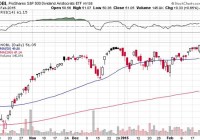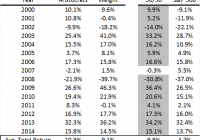Use Dividend Stocks And ETFs To Augment Long-Term Returns
Long-term investors should use high-quality dividend stocks and ETFs. Dividend stocks provide greater total returns, with dividend reinvestment, over the long term. While high dividends are nice, investors should also focus on high quality. Over the long term, high-quality, dividend-paying stocks and exchange-traded funds could produce outperforming results. Stocks with high dividend yields are the best way for investors to buy income in the current market, and if the positions are held over the long haul through short-term volatility, one may find the investment outperforming the overall market on a total return basis, writes Philip van Doorn for MarketWatch . For instance, the S&P 500 Dividend Aristocrats, which tracks over 50 stocks that have raised their dividends annually over at least 25 years, has outperformed the S&P 500 over long periods. Over the past 10 years, the S&P 500 Dividend Aristocrats have generated a 178% total return, with dividends reinvested. In contrast, the S&P 500 index has returned 117% over the same period. ETF investors can also track the S&P 500 Dividend Aristocrats through the ProShares S&P 500 Aristocrats ETF (NYSEArca: NOBL ) . NOBL has increased 11.4% over the past year, compared to the 10.4% gain in the S&P 500. The ETF also comes with a 1.62% 12-month yield. Additionally, research has found that high-quality, high-dividend stocks tend to outperform and produce better risk-adjusted returns. For instance, Chris Brightman, Vitali Kalesnik and Engin Kose found that among the largest 1,000 U.S. companies, a smaller group of 100 high-yield, high-profitability companies generated the highest total returns with the lowest volatility from 1964 through 2014. Brightman, Kalesnik and Kose also screened for quality, or distress risk, and accounting red flags, and found that the high-quality firms typically outperformed low-quality businesses. However, investors had to give up some dividend growth rates when picking high-quality companies. Investors can also track high-quality, high-dividend stocks through ETF options. For instance, the iShares Core High Dividend ETF (NYSEArca: HDV ) , which tracks high-quality U.S. companies that have been screened for financial health and relatively high dividends, has a 12-month yield of 3.40%. The Vanguard High Dividend Yield ETF (NYSEArca: VYM ) targets the largest and highest dividend-paying stocks and comes with a 2.84% yield. VYM does not sacrifice quality for its quest for yield. Instead, the ETF includes a blend of both approaches and includes about 50% of its assets in stocks with wide economic moats, according to Morningstar . Max Chen contributed to this article . Disclosure: I/we have no positions in any stocks mentioned, and no plans to initiate any positions within the next 72 hours. (More…) I wrote this article myself, and it expresses my own opinions. I am not receiving compensation for it. I have no business relationship with any company whose stock is mentioned in this article.

